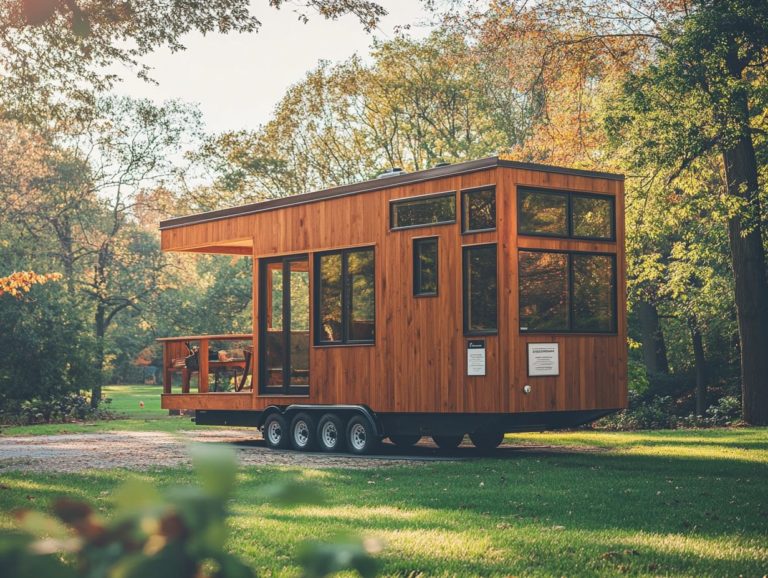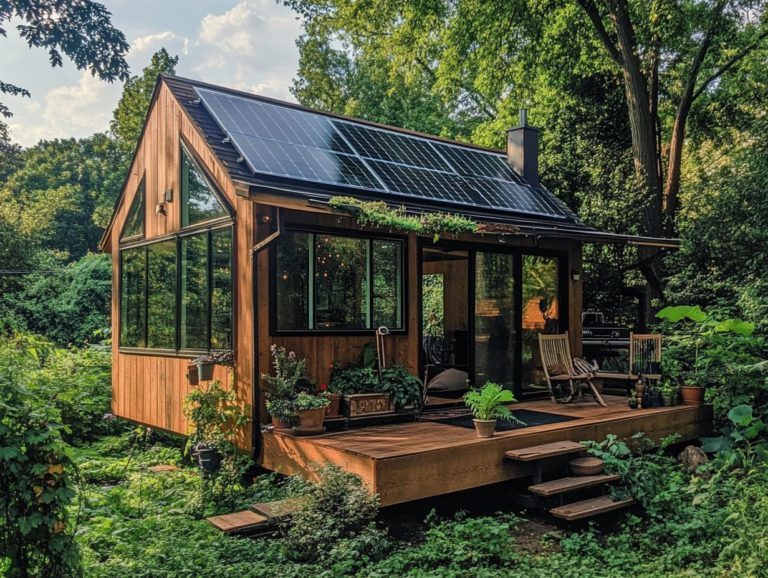What Are the Best Tiny House Movements?
Tiny homes are not merely a passing trend; they embody a profound lifestyle transition toward simplicity, sustainability, and minimalism.
As you navigate through the chaos of conventional living, the tiny house movement presents numerous avenues to explore, from off-grid living to wholeheartedly embracing minimalist principles, including modern tiny homes and shipping container homes.
This discussion delves into the various facets of the tiny house movement, highlighting its benefits such as financial freedom and a reduced environmental footprint and how you can actively participate in this transformative journey, contributing to affordable housing solutions.
It also candidly addresses the challenges that accompany downsizing and the realities of residing in a cozy space.
Are you ready to dive into the exciting world of tiny living?!
Contents
- Key Takeaways:
- What is a Tiny Home?
- Types of Tiny House Movements
- Benefits of Joining a Tiny House Movement
- How to Get Involved in the Tiny House Movement
- Challenges and Considerations of Tiny House Living
- Frequently Asked Questions
- What Are the Best Tiny House Movements and Innovations?
- Wondering which tiny house movement suits you best?
- What is the minimalism movement in tiny house living?
- What are the benefits of joining a tiny house movement?
- Can tiny house movements accommodate families?
- Can I mix aspects of different tiny house movements?
Key Takeaways:
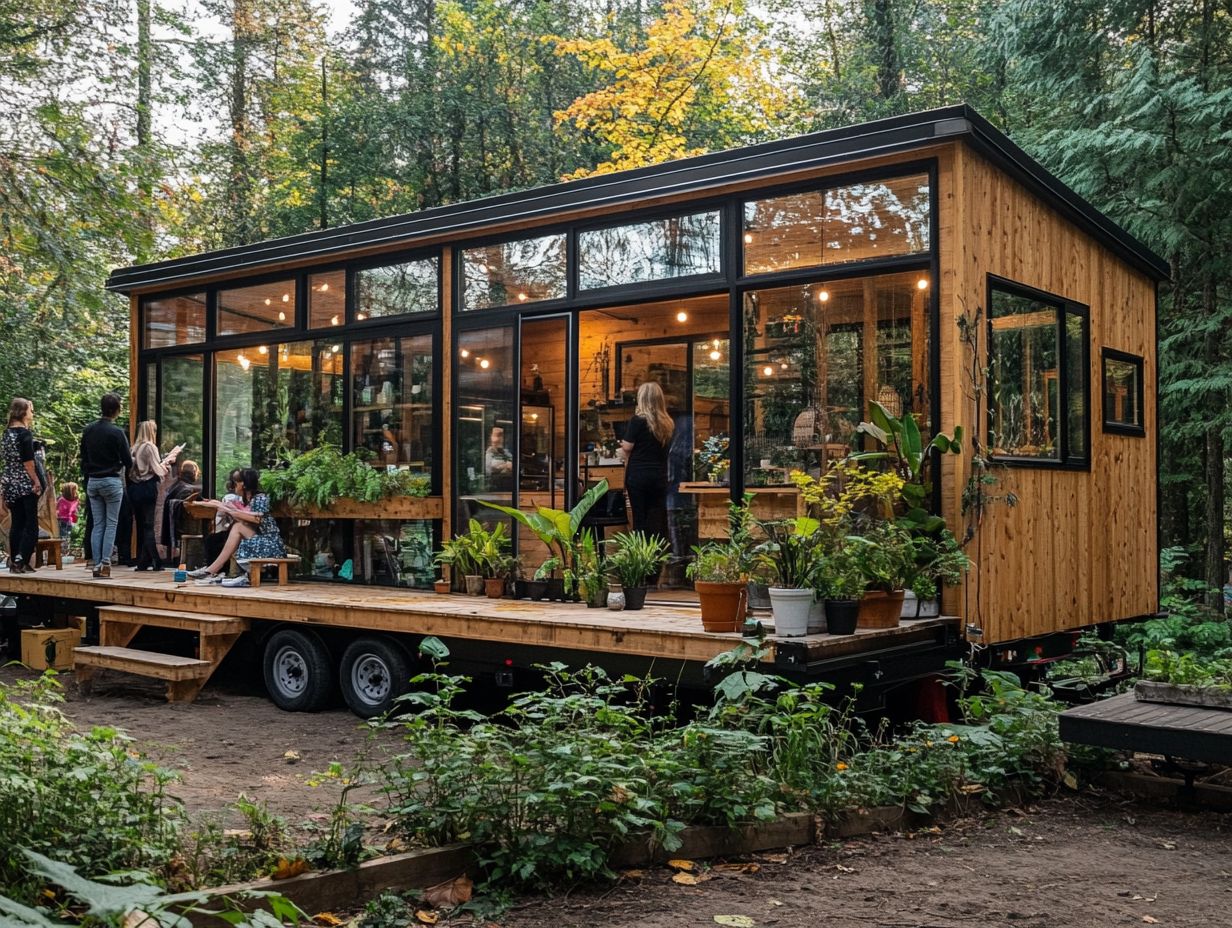
- Join a tiny house movement for financial freedom and reduced environmental impact by living simpler and more sustainably.
- Explore building your own tiny home or joining a community to share resources and experiences.
- Embrace off-grid, minimalist, and sustainable living for freedom from traditional housing norms.
What is a Tiny Home?
A tiny home is your ticket to a compact living space, typically ranging from 100 to 400 square feet, which embodies the tiny house movement’s values. This movement champions minimalism, sustainability, and affordability in housing, emerging as a response to soaring housing costs and the environmental toll of traditional homes. It appeals to those like you millennials and individuals seeking a simpler, eco-friendly lifestyle.
Tiny homes can take on various forms, from custom-built masterpieces to shipping container homes and granny pods, each crafted to enhance your quality of life while minimizing your footprint. This innovative lifestyle emphasizes thoughtful design and resource efficiency, encouraging you to downsize and declutter. For those looking to explore further, check out the best tiny house resources, ultimately leading to a more intentional existence.
By opting for a tiny home, you often discover a liberating escape from excessive debt and tedious maintenance, nurturing a deeper connection to nature and community. Embracing the tiny house movement means committing to a sustainable lifestyle, featuring eco-friendly materials and energy-efficient systems. This trend resonates particularly with those motivated by the desire to shrink their carbon footprint and live meaningfully, making tiny homes not just a smart housing solution but a pledge to a more sustainable future. For those looking to stay updated, exploring top tiny house design trends can offer valuable insights, especially in light of economic turbulence.
Types of Tiny House Movements
The tiny house movement invites you to explore a range of lifestyles and philosophies, each offering distinct perspectives on living comfortably in smaller spaces. This movement champions sustainability and minimalism, showcasing key elements like off-grid living, mobile tiny homes, park model homes, and energy-efficient designs.
This lifestyle fosters a sustainable mindset, encouraging you to connect with a broader community dedicated to innovative, eco-friendly living.
Off-Grid Living
Off-grid living within the tiny house movement captivates those like you who seek complete independence from municipal utilities, giving you the power to lessen your environmental footprint through self-sufficient systems such as solar panels, rainwater collection, and composting toilets.
This lifestyle fosters a sustainable mindset, encouraging you to harness renewable energy sources like wind and solar power for your electricity needs. Proper water management becomes essential, as you implement techniques for both collection and filtration to ensure a reliable supply for your daily activities, especially in tiny homes and earthships homes made from sustainable materials that are designed to be self-sufficient. Your waste disposal systems like composting and greywater recycling not only minimize contributions to landfills but also enrich the soil for your gardening endeavors.
While the allure of reduced utility bills and a smaller ecological footprint is undeniable, challenges do surface, particularly with initial setup costs and the ongoing maintenance required. Embracing this path demands a commitment to learning and adaptability, but the rewards can be truly transformative.
Exploring Minimalist Living
Minimalist living lies at the heart of the tiny house movement, inviting you to declutter your life and shift your focus from possessions to experiences. This transition not only enhances your quality of life but also reduces the overhead costs tied to larger homes.
By embracing minimalism, you can cultivate a profound sense of freedom and intentionality, creating room for meaningful interactions, personal growth, and a heightened awareness of your environmental impact.
Consider adopting lifestyle changes such as supporting Housing for the homeless initiatives or engaging with luminaries like Allan Wexler and Jay Shafer.
Here are some practical ways to embrace minimalism:
- Embracing a capsule wardrobe
- Scheduling regular decluttering sessions
- Prioritizing travel or hobbies over material acquisitions
Choosing to live in a tiny house or even in houseboats not only embodies this philosophy but also highlights the significance of sustainability. Smaller spaces typically consume fewer resources and promote a simpler, more mindful way of living. This harmonious blend of minimalism and tiny house living gives you the power to reevaluate what truly matters in your life.
The Power of Sustainable Living
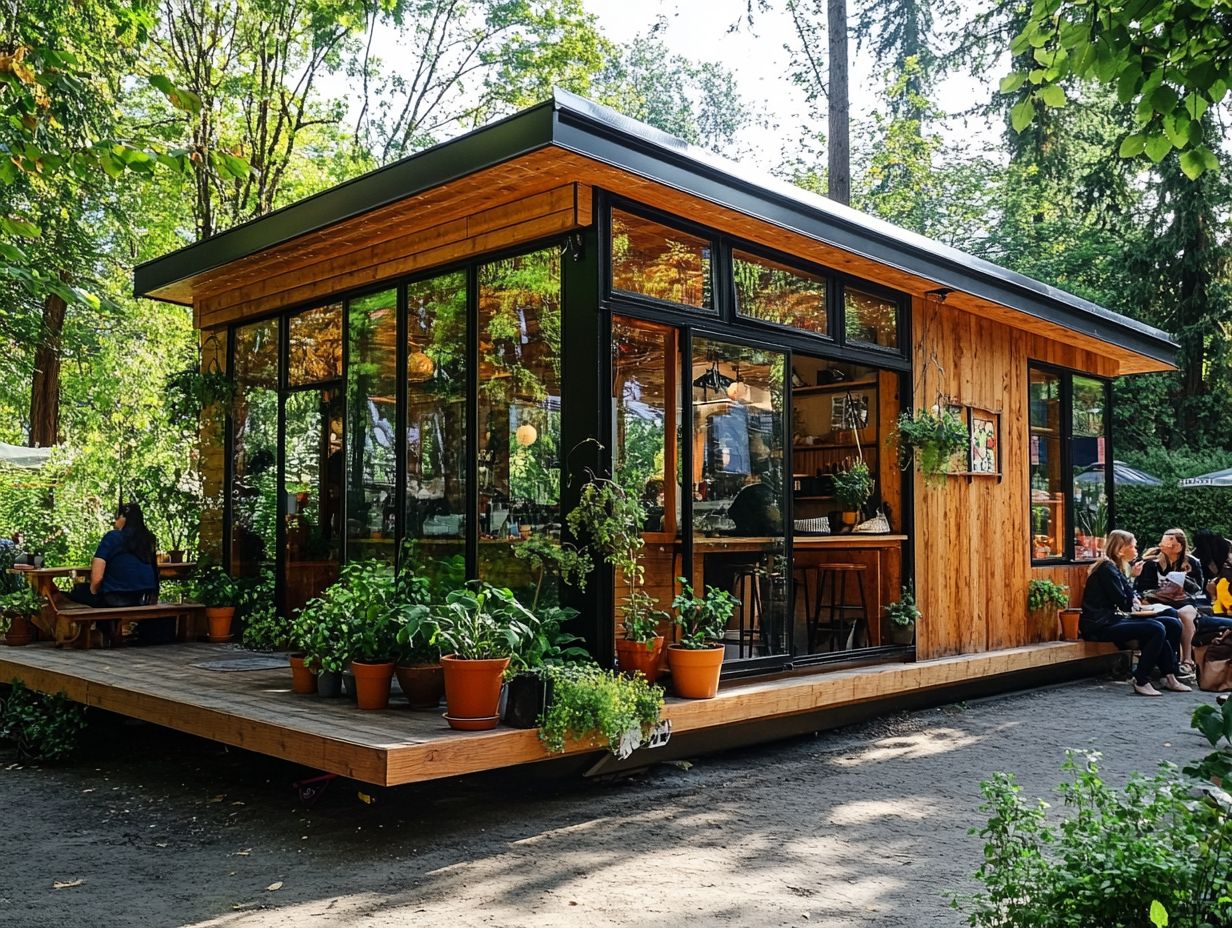
Sustainable living within the tiny house movement encourages you to adopt eco-friendly lifestyle choices that minimize resource consumption and promote energy-efficient homes. This approach provides a timely solution to the challenges of economic turbulence and environmental degradation.
By embracing minimalism and innovative design, tiny homes reflect a commitment to reducing carbon footprints—the total amount of greenhouse gases we produce—while improving your overall quality of life. To understand more about this lifestyle, you can explore the history of tiny house living. You can also enhance your home’s sustainability by incorporating solar panels, rainwater harvesting systems, and composting toilets, all of which optimize energy usage and resource management with remarkable effectiveness, reflecting the core values of the tiny house movement.
Choosing eco-friendly materials, such as reclaimed wood or non-toxic paints, showcases your alignment with a broader societal shift toward sustainable housing solutions. This not only meets your immediate needs but also lays the groundwork for a resilient future. The tiny house movement resonates with the increasing awareness of environmental responsibility, demonstrating how housing can adapt to a rapidly evolving economy.
Benefits of Joining a Tiny House Movement
Embracing the tiny house movement presents a wealth of advantages for you. Picture yourself achieving financial freedom with significantly lower housing costs, all while minimizing your environmental footprint by living in energy-efficient homes.
You’ll also gain access to affordable housing solutions that challenge the conventional ideas of homeownership, redefining what it means to have a place to call your own.
Financial Freedom
Financial freedom stands out as a key benefit of the tiny house movement, allowing you to significantly cut down on mortgage payments and overall living expenses thanks to the lower overhead costs associated with tiny homes.
This lifestyle opens the door for you to live debt-free or with far fewer financial obligations compared to traditional housing. For example, while the average American home price exceeds $300,000, you can often build a tiny house for under $100,000, potentially leading to reduced mortgage payments or even eliminating them altogether.
Tiny homes also have lower utility bills due to their compact size, which can further lighten your monthly financial load. This newfound financial relief gives you the power to redirect your savings toward experiences, travel, or retirement, allowing you to explore opportunities like building custom-built homes or participating in tiny house festivals.
The tiny house phenomenon isn’t just about minimalism; it’s about transforming lives through the gift of economic freedom. To learn more about this movement, check out what the tiny house movement is. Start your journey towards financial freedom today! Cut down on your mortgage payments and live your best life!
Reduced Environmental Impact
One of the most compelling reasons to embrace the tiny house movement is its reduced environmental impact. Tiny homes often feature eco-friendly materials and energy-efficient designs that contribute to sustainable housing solutions.
These smaller dwellings consume significantly less energy than traditional homes, often harnessing renewable sources like solar panels. By minimizing square footage, you can lower your carbon footprint considerably. Fewer materials are needed for construction and maintenance, a principle embraced by the tiny house movement. Many tiny homes incorporate reclaimed wood and recycled building materials, enhancing sustainability.
With energy-efficient appliances and insulation techniques, such as high-performance windows and roof ventilation, you can reduce energy consumption even more. Tiny houses are more than just a lifestyle choice; they represent a responsible and eco-conscious way to live.
How to Get Involved in the Tiny House Movement
Engaging with the tiny house movement can be a transformative journey for you. Whether you decide to construct your own tiny house or join a community of like-minded individuals, you’ll find a shared passion for sustainable living and minimalist lifestyles that enriches your experience.
Building Your Own Tiny House

Building your own tiny house is an exciting adventure that lets you express your unique style while embracing the principles of the tiny house movement. Whether you prefer traditional wood construction or the innovative appeal of shipping container homes, the possibilities are endless.
Before diving into this project, it s essential to outline the steps involved for a seamless experience.
- Start by establishing a budget to guide your design options and material choices.
- Sketch your ideal layout, keeping in mind necessary spaces like a functional kitchen and a cozy sleeping area that feels just right.
- Research eco-friendly materials, such as reclaimed wood or high-quality insulation, to enhance your home’s sustainability.
- Familiarize yourself with local building codes these rules determine how land can be used and can significantly impact your design decisions.
- Be mindful of common pitfalls, like underestimating costs or neglecting to secure necessary permits, which can easily derail even the most meticulously crafted plans.
Joining a Community
Joining a community within the tiny house movement provides a wealth of support, resources, and connections. You ll share experiences and collaborate on initiatives such as park model homes and innovative solutions for homelessness.
This communal aspect cultivates a sense of belonging. As you engage in networking opportunities, you’ll discover pathways to shared projects and sustainable living solutions. By pooling resources and knowledge, you can tackle the challenges of tiny living effectively whether it’s navigating zoning regulations or embracing eco-friendly building practices. To explore more, check out what are the most popular tiny house styles, informed by thought leaders like Jay Shafer and Sarah Susanka.
Participating in group workshops and communal builds hones your skills and fosters meaningful relationships. Don’t miss out on the chance to connect with others in a supportive environment where creativity and sustainability take center stage.
As these networks expand, they play a crucial role in amplifying the tiny house movement, highlighting the importance of community in transforming lifestyles and addressing housing crises.
Challenges and Considerations of Tiny House Living
The tiny house movement offers numerous benefits but also presents its share of challenges and considerations. You ll need to navigate zoning and legal issues and make necessary adjustments to live comfortably in a compact space.
Zoning and Legal Issues
Zoning and legal issues can significantly impact your journey in the tiny house movement, as regulations vary widely. These differences can affect everything from where you can place your mobile tiny home to compliance with the International Residential Code and how these codes interact with local zoning laws.
Legal frameworks may impose restrictions that present challenges for you as a potential owner or builder. They often determine whether tiny houses can be located in urban settings or on private land. Common hurdles include overly restrictive zoning laws, building codes that don’t cater to smaller structures, and a lack of designated zones for tiny homes. If you’re interested in tiny house living, you might also enjoy exploring the best tiny house shows to watch.
Navigating these complex rules requires a solid understanding of local regulations and may involve consulting with city planners or legal experts. You can find many resources, including advocacy groups that champion housing for the homeless and online forums, which provide guidance on how to effectively maneuver through these barriers. Additionally, knowing the best location for a tiny house can enhance your journey. This support empowers you as you explore the possibilities within the tiny house movement.
Adjusting to a Smaller Living Space
Adjusting to a smaller living space is a pivotal journey for anyone venturing into tiny house living. You ll need to change how you think, embracing a minimalist lifestyle that values quality of life over material possessions.
This transition stirs a unique blend of excitement and anxiety, compelling you to confront what genuinely adds value to your life. The psychological journey involves letting go of attachments to items that no longer serve a purpose, exploring your personal preferences, and reexamining your daily habits and routines.
To make this process smoother, effective decluttering is essential. Start by sorting your belongings into keep, donate, or discard piles, ensuring each item has a distinct purpose. Embrace smart organization techniques, such as using multifunctional furniture and optimizing vertical space, to maximize efficiency while keeping in mind layouts popularized by pioneers like Sarah Susanka.
By embracing this change, you ll gain mental clarity and develop a deeper appreciation for experiences over possessions as you engage in community events. This creates a serene environment that fosters mindfulness and intentional living.
Frequently Asked Questions
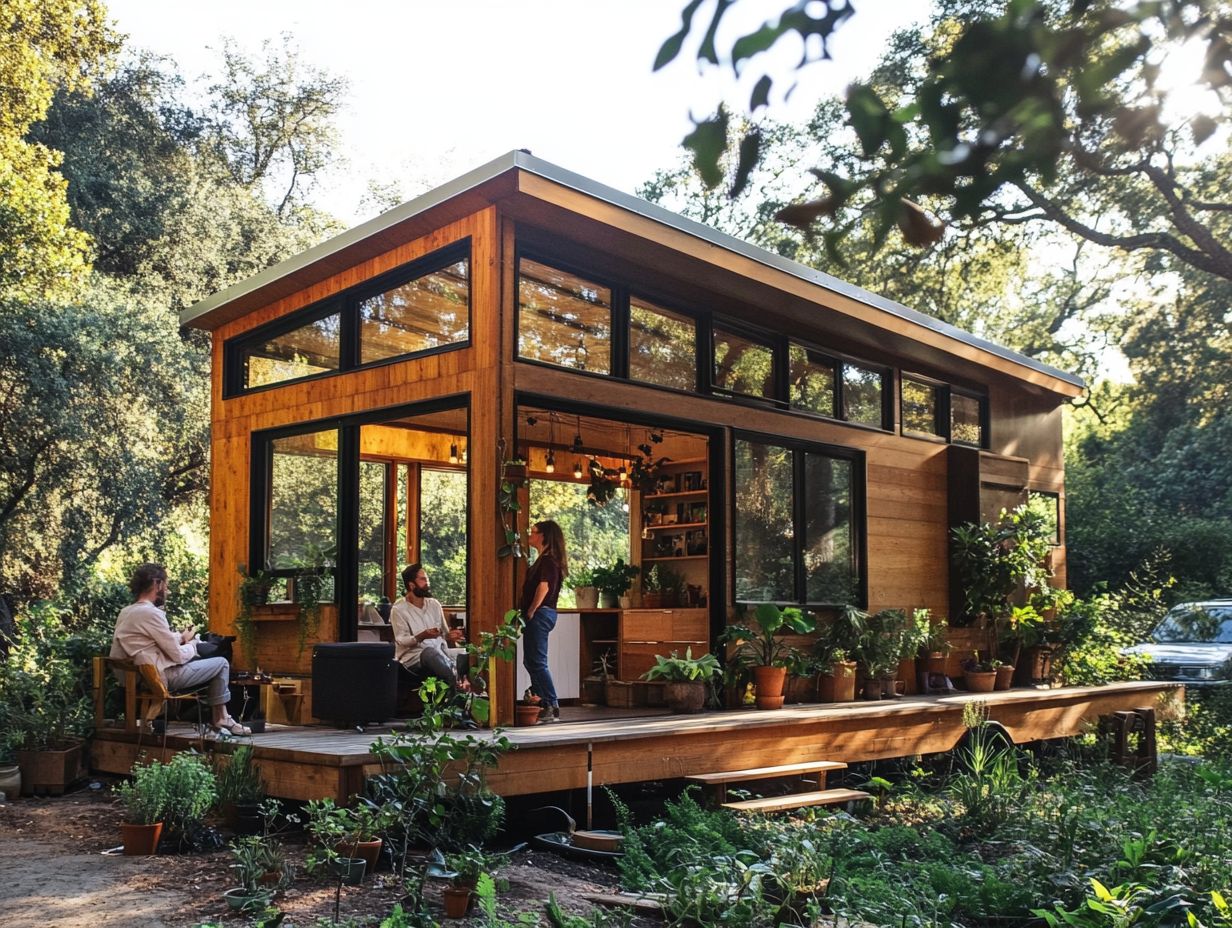
What Are the Best Tiny House Movements and Innovations?
The best tiny house movements align with your values and lifestyle. Popular movements include minimalism, sustainability, and off-grid living, influenced by cities like Cincinnati.
Wondering which tiny house movement suits you best?
Start by reflecting on your values and what you hope to gain from tiny living. Research different movements, including the teachings of Jay Shafer and Allan Wexler, to see which ones resonate with you the most.
What is the minimalism movement in tiny house living?
The minimalism movement in tiny house living focuses on simplifying and decluttering your life. It encourages living with less and being intentional with your possessions.
What are the benefits of joining a tiny house movement?
Joining a tiny house movement can provide a sense of community and support, helping you live a more sustainable and fulfilling lifestyle that addresses modern challenges.
Can tiny house movements accommodate families?
No, tiny house movements can also accommodate families. Many examples exist of families living happily and comfortably in tiny homes, showcasing the adaptability of this lifestyle.
Can I mix aspects of different tiny house movements?
No, you can combine different aspects of various movements to create a lifestyle that works best for you. The important thing is to find what brings you joy and fulfillment in your tiny home, echoing the philosophies of Little House on a Small Planet.



